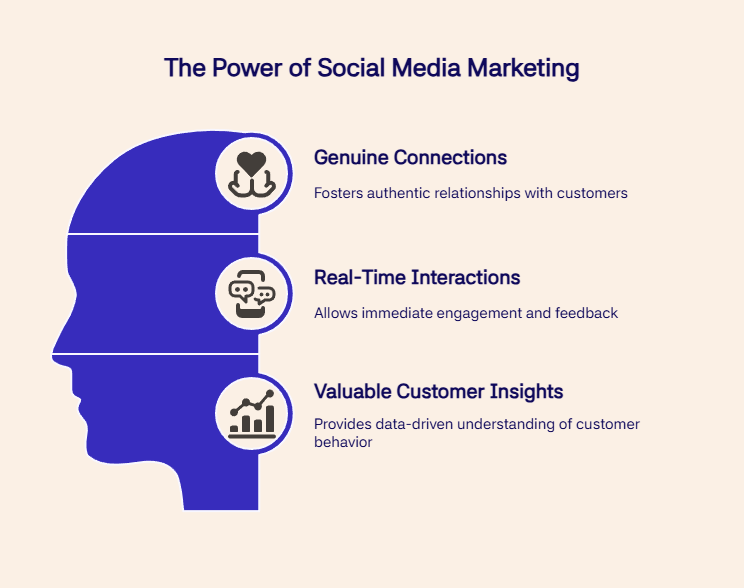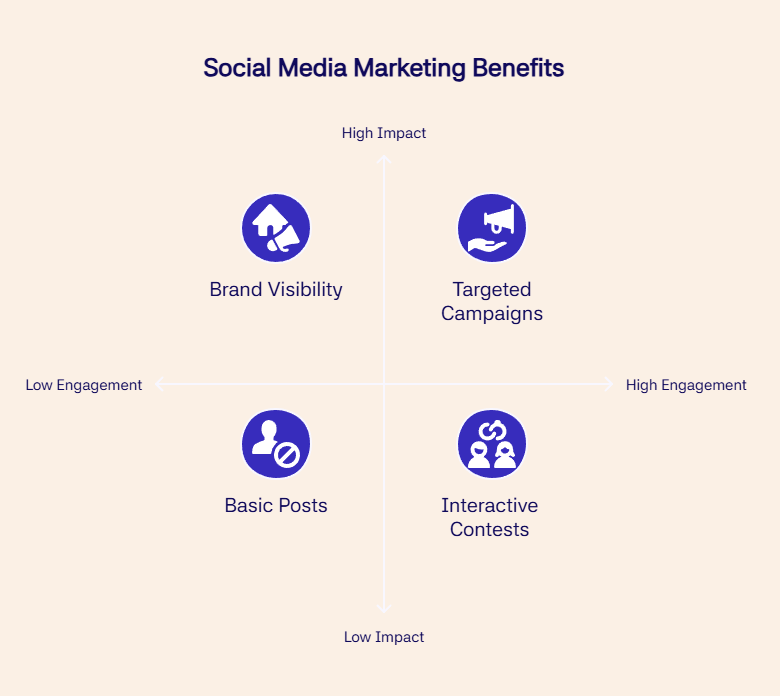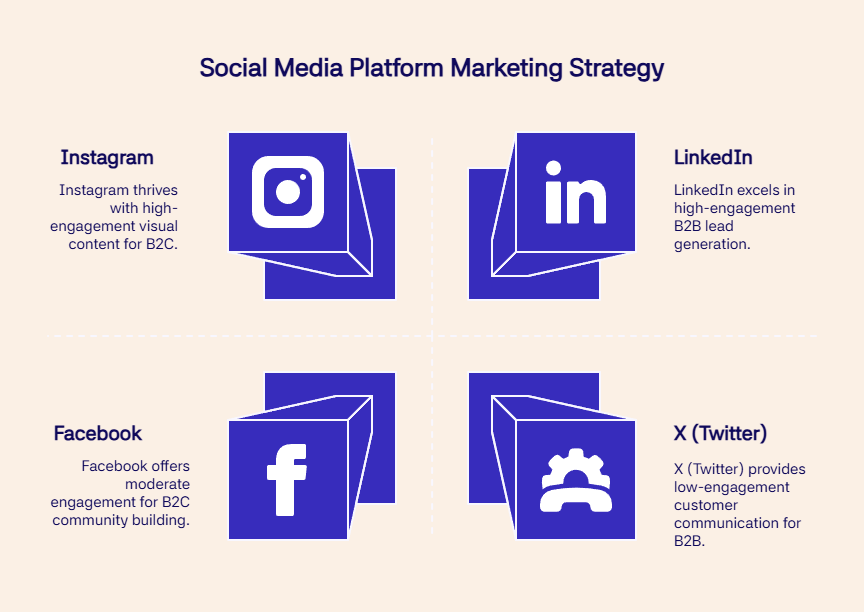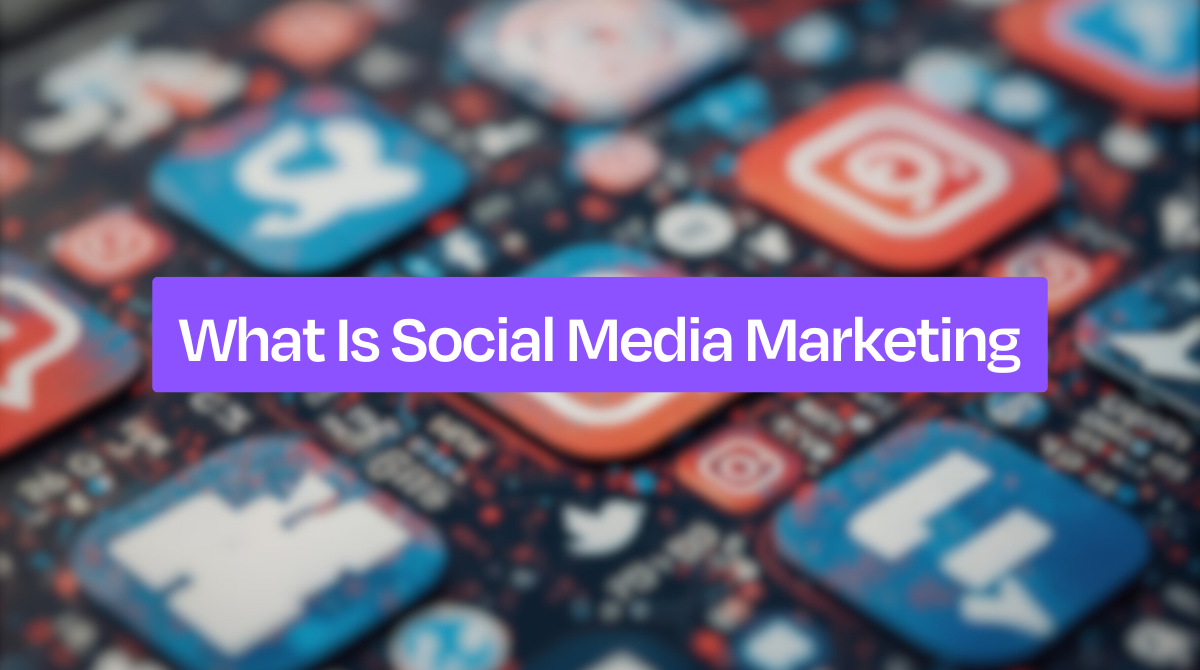Social media marketing is a type of marketing that utilizes platform-specific content to reach, engage, and convert audiences. People spend 143 minutes per day on social apps, which is over 2 hours of conversion opportunity across Instagram, TikTok, Facebook, and LinkedIn.
Win attention by setting goals, defining your audience, publishing on a schedule, engaging within 24 hours, and tracking leads and revenue, not likes.
Ready to turn those 143 daily minutes into real results? Let's dive into a framework that'll help you build a social media presence that converts.
TL;DR:
-
Social media marketing converts 143 daily minutes of user attention into measurable leads, traffic, and sales growth
-
Focus on 2-3 platforms where your audience is active rather than spreading thin across all channels
-
Set SMART goals, engage authentically with followers, and track metrics monthly to improve ROI
-
65% of marketers generate leads and 73% increase website traffic through strategic social media campaigns
The Real Reason Social Media Marketing Works So Well
Social media marketing works so well because it builds genuine connections, enables real-time interactions, and delivers valuable customer insights. It's one of the most trending digital marketing strategies.

Here's why these three elements make all the difference.
Connection: Meeting Your Audience Where They Already Are
Social media connects you to customers by meeting them where they already spend time, from YouTube to Facebook to X. It works like free storefronts in every neighborhood your audience visits.
It's like having multiple storefronts in every neighborhood where your customers hang out – except these storefronts are free.
Interaction: Turning Customers Into Your Marketing Team
Social media turns customers into your marketing team because every like, share, comment, and recommendation becomes free electronic word-of-mouth or eWOM advertising. Customer interactions spread your content to their friends. It's like a referral marketing channel on autopilot.
And the best part? You can measure this social equity, meaning you can track the real return on investment from all those interactions.
Customer Data: Your Secret Weapon for Smarter Marketing
Social media provides powerful customer data by turning platforms into goldmines of insights. Tools extract the exact information you need to understand customers and improve marketing.
You get insights into what they like, when they're online, and what makes them tick – all of which helps you create more targeted, effective marketing strategies.
Benefits of Social Media Marketing
Social media marketing benefits businesses by delivering measurable growth. According to the Social Media Marketing Industry Report, 65% of marketers generated leads, 73% increased traffic, 52% boosted sales, 62% built loyal fans, and 83% improved brand visibility and recognition.

Expand Your Brand’s Reach
Social media expands your brand’s reach by putting it in front of millions of daily users. Engagement through likes, shares, comments, and saves turns your audience into promoters.
Your social presence also drives website traffic by linking offers in bios, posts, and profiles, which makes it one of the most effective brand marketing strategies.
Turn Visitors into Customers
Social media turns visitors into customers by creating sales touchpoints through product promotions, contests, live videos, and targeted campaigns.
Here's how to make it happen:
-
Run contests that drive traffic back to your website with links in your bio and posts
-
Host live videos to showcase new products and share exciting company updates
-
Launch targeted campaigns on your best-performing social channels
-
Enable direct selling through platform features like Facebook Shop or Instagram Shopping
For example, platforms like Instagram Shopping enable direct purchases without leaving the app, acting as mini storefronts inside your profile that drive conversions.
Build Lasting Customer Connections
Build lasting customer connections on social media by engaging with followers through replies, support, and questions.
Hosting giveaways and encouraging feedback shows you value customer input and strengthens relationships with your business.
Stay Ahead by Studying the Competition
Social media helps you study competitors by revealing their successful and failed campaigns while showing how audiences react to products and strategies.
Competitive insights guide strategy by showing what to copy, avoid, or change. Here's a great study result. Poppi’s 2025 Super Bowl campaign backfired after sending 32 influencers costly vending machines, sparking backlash for being out of touch.
Ollipop, a competitor of Poppi, turned Poppi’s failed campaign into a marketing win by joining the conversation. Their comment, “32 machines times $25K per machine, yikes,” highlighted the mistake and positioned them smartly against their competitor.
Which Social Media Platforms are Best for Marketing?
The best social media platforms for marketing depend on your audience and goals.
Facebook (3.065B users) works for B2C Millennials, Instagram (2.4B) targets Gen Z and Millennials with visuals, X (600M) excels in customer communication, LinkedIn (770M) drives B2B leads, and YouTube (2.5B) builds trust with long-form videos.

Let's break down the heavy hitters so you can figure out where to focus your energy and budget for maximum impact.
-
Active Users: 3.065 billion
Facebook remains the top social platform with 3.065 billion users, dominated by Millennials aged 25–34. Nearly half of users are Millennials, while only 19% of teens use it daily.
Image posts drive the most engagement, over half take action on brand stories, and 50% of the time is spent watching videos.
The winning strategy? Mix images with videos, especially Facebook Live. Facebook Ads are also incredibly accessible – you can drive real website traffic starting at just a few dollars per day.
-
Active Users: 2.4 billion
Instagram dominates visual marketing with over 60% of users aged 18–34. It leads influencer marketing, and Reels achieve the highest reach.
About 70% of shoppers use Instagram to find buying opportunities, while short narrative-style Stories remain the most popular format.
Focus on short-form videos and relatable content to connect with younger demographics. Don't sleep on influencer partnerships either. 39% of consumers are more likely to buy products recommended by influencers.
X (Twitter)
-
Active Users: 600 million
-
Why it works: Direct customer service and community management
X dominates direct customer communication, handling nearly 80% of social media service requests. While smaller than Facebook or Instagram, it excels at building loyal fanbases through real-time conversations.
Key stats that matter: 48% of users rely on X for breaking news, 79% follow brands, and tweets with hashtags get 100% more engagement.
Video tweets? They get 10x more engagement than regular posts.
-
Active Users: 770 million
-
Why it works: High-quality lead generation and B2B partnerships
LinkedIn drives business growth by connecting with CEOs, decision-makers, and professionals. Ads reach over 14% of the global population, and active company pages earn five times more views than inactive ones, making it a goldmine for B2B marketing.
LinkedIn is effective because image content doubles engagement, weekly posting doubles activity, and it generates 277% more high-quality leads than Facebook or X. It is ideal for reaching high-intent clients actively searching for services.
Youtube
-
Active Users: 2.5 billion
-
Why it works: Long-form video content that builds deep connections
YouTube ranks among the most visited sites worldwide and excels at long-form content. Explainers, tutorials, and behind-the-scenes videos allow brands to explore topics in depth, building loyal communities that TikTok’s short clips cannot match.
When you can spend 10-15 minutes delivering real value, you're not just getting attention, you're earning trust in ways that 30-second clips simply can't match.
What Does a Social Media Marketer Do?
A social media marketer promotes products, engages customers, and announces launches through platforms like Facebook, Instagram, TikTok, and X. They create posts that capture attention and can work full-time for a company or freelance with multiple clients.
Either way, they're crafting those posts that actually make you stop scrolling and pay attention.
How to Create a Social Media Marketing Strategy
Create a social media marketing strategy by setting SMART goals, knowing your audience, and auditing your current presence. Focus on 2–3 platforms, plan engaging content, and interact with followers. Track metrics monthly to improve results and align campaigns with business objectives.
Here's how to build one that actually works.
Step 1: Set SMART Goals That Matter
Set SMART goals by making them specific, measurable, and tied to business growth. Replace vague targets like “get more followers” with “increase website traffic by 25% in 3 months” or “generate 50 qualified leads per month.”
Always use clear numbers and deadlines for awareness, sales, or community goals.
Step 2: Know Your Audience Inside and Out
Know your audience by analyzing demographics, online habits, and content preferences. Study their age, location, income, and when they are active online. Build detailed buyer personas that resemble real people to create content that resonates and connects.
Step 3: Audit Your Current Social Presence
Audit your social presence by reviewing profiles, content performance, and engagement rates. Identify what earns likes and shares and what fails to connect. Study competitors to spot effective strategies you can adapt for your brand.
Step 4: Pick Your Platforms Wisely
Focus on 2–3 platforms where your audience is active and your content fits best. A strong presence on Instagram and LinkedIn is more effective than spreading thin across six platforms.
Step 5: Plan Content That Connects
Develop content pillars that reflect your brand and engage your audience. Use a mix of videos, images, stories, and text posts. Plan posts in advance to stay consistent and avoid the daily stress of deciding what to share.
Step 6: Actually Engage (Don't Just Broadcast)
Engage on social media by responding to comments, answering questions, and starting conversations. Run contests, share user-generated content, and highlight the human side of your brand. People follow brands they connect with, not those that only broadcast messages.
Step 7: Track, Learn, and Improve
Finally, Track key metrics like engagement rates, website clicks, and lead generation to measure progress toward goals. Review performance monthly to identify what works and refine strategy using real data instead of assumptions.
Pros and Cons of Social Media Marketing
Here's an honest look at both the advantages and challenges you'll face when diving into social media marketing for your business.
Pros
-
Massive Brand Exposure on a Budget
-
Direct Connection with Your Audience
-
Targeted Reach That Actually Works
-
Measurable Results You Can Track
Cons
-
Time-Intensive Daily Commitment
-
Algorithm Changes Can Kill Your Reach
-
Public Criticism Spreads Fast
-
ROI Can Be Hard to Pin Down
What Is Sticky Content in Social Media Marketing?
Sticky content in social media marketing is content designed to capture attention, keep users engaged, and encourage repeat visits or shares. It often includes entertaining, valuable, or interactive formats like videos, memes, polls, and guides that spark interaction and build stronger brand loyalty.
What Is Viral Marketing in Social Media Marketing?
Viral marketing in social media marketing is a strategy that spreads content rapidly through shares, likes, and comments. It relies on highly engaging, entertaining, or emotional content that encourages users to promote it organically, creating massive reach, brand awareness, and exponential visibility at little or no cost.
FAQs
How long does it take to see results from social media marketing?
You can expect to see initial results from social media marketing within 3–6 months. Growth depends on content consistency, audience targeting, and engagement. Faster results come from paid advertising, while organic growth requires more time and steady effort.
How much should I budget for social media marketing?
Budget 5–15% of your total revenue for marketing, with a portion allocated to social media. Small businesses may spend $500–$2,000 per month, while larger companies often invest $5,000 or more, depending on ad spend, tools, and content creation.
Which social media tools can help manage content and track performance?
Tools like Hootsuite, Buffer, and Sprout Social manage scheduling and publishing. Analytics platforms such as Google Analytics, Meta Insights, and HubSpot track performance. Canva and Adobe Express help design engaging visuals.
Do I need to be on every platform to be successful?
You do not need to be on every platform. Focus on 2–3 platforms where your audience is most active and your content style fits best. A strong, consistent presence on fewer platforms is more effective than being spread thin across many.
Should I hire a social media agency or keep it in-house?
Hire a social media agency if you need expert strategy, content production, and faster results. Keep it in-house if you have the team, time, and resources to manage campaigns. Many businesses use a hybrid approach, an outsourcing strategy, while handling daily engagement internally.
What are the five pillars of social media marketing?
The five pillars of social media marketing are strategy, planning and publishing, listening and engagement, analytics and reporting, and advertising. These pillars guide marketers to set clear goals, publish consistent content, interact with audiences, track performance with data, and use paid promotions to expand reach and impact.
What are the 7 P's of social marketing?
The 7 P’s of social marketing are product, price, place, promotion, people, process, and physical evidence. These elements help businesses design campaigns by defining what they offer, how it’s priced, where it’s delivered, how it’s promoted, who delivers it, the process used, and the proof of value.
Wrap Up
Social media marketing is all about using platforms like Instagram, Facebook, and TikTok to connect with customers, build your brand, boost sales, and drive traffic to your website. With billions of people scrolling social media daily on their phones and computers, the opportunity to reach and convert customers is massive.
The challenge? Everyone's fighting for those same views and clicks, which means your strategy needs to be smart, engaging, and authentic to stand out in the crowd.





